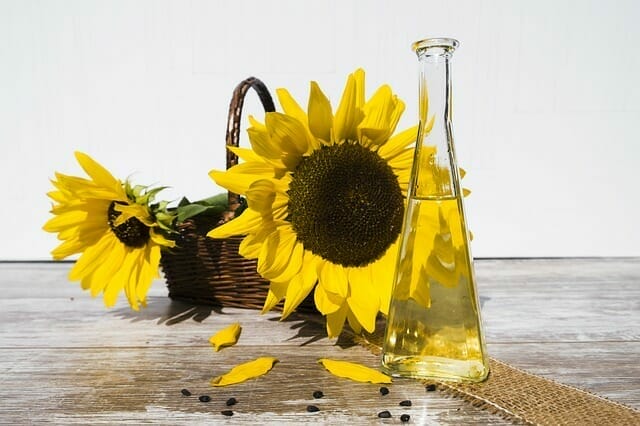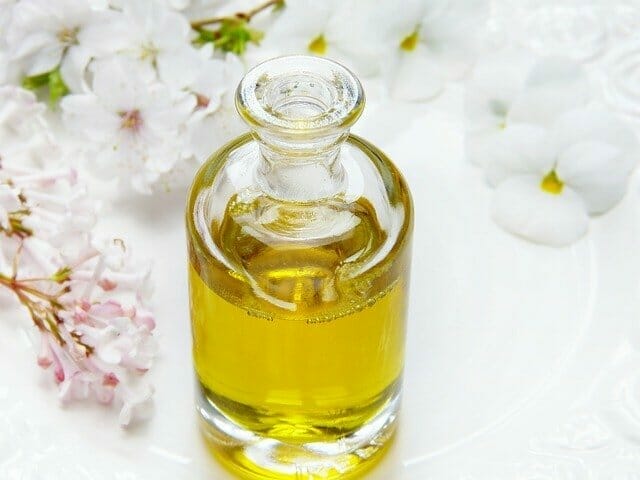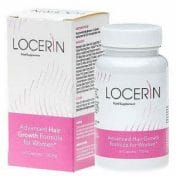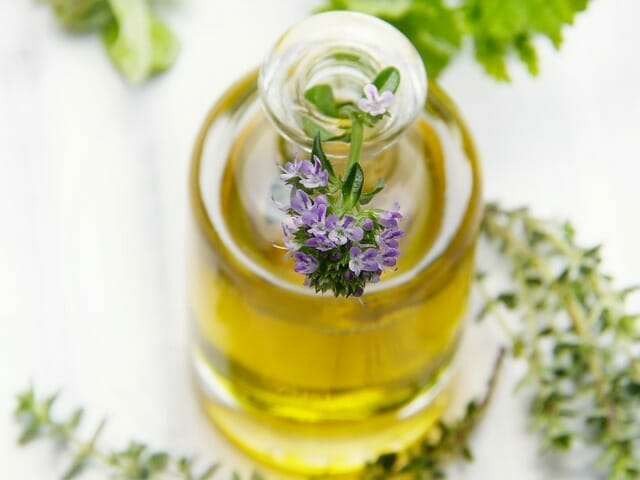Using hair oils is becoming increasingly popular as an additional form of hair care or as an alternative to ready-made cosmetics. In fact, hair oil is not a new hair care method, but has a centuries-old tradition. Oils are a natural and highly effective way to deeply nourish hair.
Hairoils help virtually any problematic hair – brittle, fragile, dry, dehydrated, weak, as well as hair with dandruff and hair prone to shedding. However, not every oil will be equally effective on every hair type. Depending on its composition, some oils are best for damaged, rough (highly porous) hair, while others are best for hair with a smoother texture. How do I use hair oils? Which Hair Oil Should I Choose?
Table of contents
- 1 Hair Types and Hair Oils
- 2 Hair oils – 6 proven hair oil methods
- 3 The best oils for hair – top 6 oils that will renew the face of your hair!
- 3.1 Wheat Germ Oil – the recipe for perfectly conditioned, shiny, smooth hair
- 3.2 Babassu Oil for Well-Moisturised, Beautiful Hair and a Disciplined Style
- 3.3 Burdock oil – strengthening and regeneration of hair and scalp health in one
- 3.4 Argan Oil – An Exotic Natural Serum for Healthy, Strong Hair
- 3.5 Nigella Oil – a Method for Strong, Vital and Shiny Hair
- 3.6 Invaluable linseed oil – for hair requiring immediate regeneration
Hair Types and Hair Oils

Hairoils are not only a patented way to nourish and regenerate your hair but also a method to efficiently condition and comprehensively improve the appearance of your hairstyle. Each vegetable oil has its own specific composition, in which saturated fatty acids and unsaturated fatty acids (monounsaturated and polyunsaturated) occur in given proportions. Depending on the amount of fatty acids, some oils work well for light, thin and frizzy hair while others work well for heavy and thick hair. Which oils are best for which hair types?
Different hair types according to porosity (the degree of separation of the keratin scales)
- Highly porous hair is hair with very porous hair, where the keratin scales are very distorted from the hair shaft. The hair structure is uneven and quite rough. It is often static and fly-away. After shampooing, they dry quickly. They are usually dry, brittle, thin, dull and damaged. Their ends split and crumble easily. They have an increased tendency to fall out, are sensitive and delicate, easily damaged. The hair is difficult to comb but easy to curl and style.
- Medium-Rough Hair is slightly away from the roots and relatively smooth but can also be somewhat rough. It is of normal thickness but the ends tend to split quite often. With proper care they are not problematic. They have a natural sheen but can also be slightly dull. They are quite manageable and easy to comb, but they can be capricious. Under the influence of humidity they get frizzy, in the winter period they get greasy due to hats worn, and in the heating season they often get electrified. The more aggressive forms of styling (e.g. frequent blow-drying, straightening with a flat iron, bleaching) and the lack of suitable protection dry out and damage hair.
- Low-Performance Hair is characterised by closely packed and closed cuticles. Low-Perflected hair is characterised by its noticeable smoothness and elasticity. The hair is highly moisturised and does not tend to dry out. It takes a long time to dry after shampooing. They are heavy, usually straight, shiny and thick in texture. They are strong and resistant to damage, even more aggressive hairdressing treatments or frequent hot styling does not reduce their quality. Due to their heavy weight they tend to look dull and lack volume. They are difficult to style, difficult to curl and require a fair amount of hold to stay in place.
Which oils are right for which hair types?
The best oils forhigh porous hair are those with ahigh content of unsaturated fatty acids (especially polyunsaturated fatty acids). Due to their large molecules, these oils are effective in sealing the hair cuticles, improving the hair structure, weighing downThey also deeply moisturize, regenerate and nourish hair. They also provide an extra layer of protection against the harmful effects of external factors.
All oils rich in unsaturated fatty acids, especially those rich in monounsaturated fatty acids, are ideal for thecare of medium-porous hair. Thanks to their medium molecules they help to close the hair cuticle, give the hair depth and provide good elasticity.The medium-sized molecules help close the hair cuticle, give the hair depth, ensure that the hair is well-balanced and well-moisturised. At the same time, they prevent frizz and improve the condition of the hairstyle without weighing it down.
The most suitable vegetable oils for thecare of low-pored hair are those, the composition of which is dominated by saturated fatty acids. These oils have small molecules, which means they do not weigh hair down. Instead, they add volume, condition and regulate sebum secretion.
The Best Oils for High-Performance Hair
- Argan oil,
- black cumin oil,
- evening primrose oil,
- linseed oil,
- grapeseed oil,
- sunflower oil,
- raspberry seed oil,
- avocado oil,
- safflower oil,
- pumpkin seed oil,
- hemp oil,
- soybean oil,
- wheat germ oil,
- cottonseed oil,
- rose oil.
The Best Oils for Medium-Rough Hair
- Macadamia oil,
- castor oil,
- olive oil,
- argan oil,
- rice oil,
- canola oil,
- sweet almond oil,
- apricot kernel oil,
- jojoba oil,
- camellia oil,
- hazelnut oil,
- sesame oil.
The Best Oils for Low-Rubborn Hair
- coconut oil,
- palm oil,
- shea butter,
- cocoa butter,
- mango butter,
- castor oil,
- babassu oil,
- baobab oil,
- pomegranate seed oil,
- moringa oil.
Hair oils – 6 proven hair oil methods

Oiling your hair with one oil or a mixture of several hair oils can be done in several different ways. These techniques differ in the amount of oil applied and the length of time needed for the treatment – some oil treatments last only a few minutes while others last for several hours.
Some of these methods work best for women with very porous hair (e.g. the overnight oiling method) while others work best for women with medium- or low-pored hair (e.g. quick oiling in 30 minutes or oiling with a mixture of oil and water).
The most popular hair oiling methods are:
Oiling hair dry overnight
Apply 1-2 tablespoons of hair oil previously rubbed in the palms of your hands to combed hair. Distribute it throughout the length of your hair. If your hair tends to be greasy at the roots, apply the oil from the mid-lengths to the ends. Make a braid or a bun. Place a thick towel on your pillow to avoid getting it dirty. In the morning, after oiling your hair, wash it thoroughly with a mild shampoo.
Quick dry oiling
This method of oiling is optimal for us if we prefer the simplest, least demanding hair care treatments and if we have little time (for example, we plan to leave home in an hour). Apply the chosen oil to dry and combed hair (about 1 tablespoon of oil), paying special attention to the ends. Wait for about 20 minutes and then wash your hair. If you have a little more time or if your hair is very damaged or dry, you can extend the oiling to 30 minutes or an hour.
Wet hair oiling
Apply 1-2 tablespoons of oil to very wet hair (almost from the roots in the case of dry hair or from mid-length in the case of normal or oily hair). After about 1.5 hours, rinse your hair and then wash it.
Oil treatment with conditioner
Soak your hair and then lightly drain excess water. Apply a conditioner and then apply a small amount of hair oil, which has been spread in the palms of your hands, to the conditioner. Alternatively, you can combine the oil with the conditioner and apply the concoction to your hair. Wait 20-30 minutes, rinse the mixture out of your hair, and then wash your hair with a mild shampoo.
Oiling your hair with a mist
Selected hair oil or oils combine with herbal infusion (e.g. nettle, chamomile, calamus, burdock, rosemary) in the proportion of 1 incomplete spoon of oil for about 200 ml of the infusion. The infusion can also be replaced by a ready-made mist or hydrolate for hair. Pour the mixture into a bottle with an atomizer, stir. Spray the mixture on your hair, trying to avoid the scalp. Comb through and you’re done.
Oiling in a bowl
This method is also called the “broth method” because the water in which you soak your hair forms characteristic fatty eyes like in broth. Pour warm water into a large bowl (enough water to allow your hair to float) and then add natural vegetable oils (1 or 2 tablespoons). Immerse your hair, rinse for a few minutes while massaging your scalp. Drain your hair, wait 30 minutes and then wash your hair.
The best oils for hair – top 6 oils that will renew the face of your hair!

Which hair oil to choose? All plant oils have been shown to have beneficial effects on hair, but each has slightly different properties depending on the active ingredients present. When looking for the perfect hair oil for your hair, you may want to try a few different oils or experiment with different blends.
Here are some interesting suggestions for hair oils, each of which is endowed with many valuable properties!
Wheat Germ Oil – the recipe for perfectly conditioned, shiny, smooth hair
Thanks to its unique properties, wheat germ oil is perfect for taking care of highly porous hair. It contains a wealth of vitamin E and a wide range of other valuable bio-ingredients. It perfectly nourishes the hair, adds strength and repairs damage to its structure. It also shows moisturising properties, smoothes the hair and adds shine. It prevents split ends and frizzy hair, protects against damage, reduces hair loss and stimulates hair growth.
Babassu Oil for Well-Moisturised, Beautiful Hair and a Disciplined Style
The perfect oil for low-pored hair. It smoothes and softens hair, improves its flexibility and elasticity, makes it more manageable, less capricious and more susceptible to styling treatments. It moisturizes, nourishes, and has a protective effect, comprehensively improving the appearance of the hairstyle.
Burdock oil – strengthening and regeneration of hair and scalp health in one
Burdock is one of the most effective herbs used against hair loss and to stimulate hair growth. It is also an effective antidote for ailments related to the deteriorated condition of the scalp and the malfunction of the sebaceous glands, including seborrhea and dandruff. Burdock oil is available in its pure form or in compositions with other ingredients supporting proper functioning of the scalp and improving hair condition, e.g. with field horsetail.
Burdock oil shows anti-inflammatory and normalizing effects (regulates sebum production). At the same time, it perfectly moisturises the hair, regenerates it, soothes irritations and improves the hair structure.
For people struggling with hair loss and slow hair growth it is worth recommending burdock oil enriched with ingredients stimulating microcirculation and improving hair structure.The ingredients stimulate microcirculation and improve blood supply to the scalp (one of the best such ingredients is chili pepper extract). Thanks to these additives, the skin cells are better oxygenated and nourished, and the oil’s active ingredients are better absorbed by hair follicles and roots.
Argan Oil – An Exotic Natural Serum for Healthy, Strong Hair
Argan oil is ideal for women with highly porous and medium porous hair. This exotic oil, which arrived in Europe from Morocco, is rich in vitamin E, unsaturated fatty acids and antioxidants.
Argan oil is a natural hair serum, revitalising and nourishing. It also protects against the loss of moisture and against harmful external factors (e.g. solar radiation). It supports the reconstruction of damaged hair, prevents hair breakage, provides healthy look and protects hair ends from splitting. What is more, it accelerates hair growth and strengthens hair bulbs. That is why oil treatments, masks and rubs made of argan oil are worth recommending to people struggling with weakened and excessively falling out hair.
Nigella Oil – a Method for Strong, Vital and Shiny Hair
Black cumin oil is a true discovery when it comes to caring for weakened hair that needs to be thoroughly nourished. The nigella seed contains many unsaturated fatty acids, which are extremely valuable to hair cells, as well as a host of minerals, amino acids and vitamins. Used in the form of masks and scalp rubs, black cumin oil strengthens hair follicles, inhibits baldness and ensures faster hair growth. It also effectively regenerates tired, thin, dull, brittle and fragile hair.
Invaluable linseed oil – for hair requiring immediate regeneration
Linseed oil is a highly valued product, both in cosmetics and in natural medicine. It contains large amounts of valuable omega 3, omega 6 and omega 9 unsaturated fatty acids and, what is most important, in very beneficial proportions for the human body.
Linseed oil applied on hair is highly effective in hair regeneration process. It strengthens hair follicles and roots, protects hair from damage and has a repairing effect on it. What is important for men struggling with thinning hair, it also helps to reduce the level of DHT hormone responsible for androgenic alopecia.
Check out the multi-ingredient formula for strengthening, renewing and accelerating hair growth: Locerin


